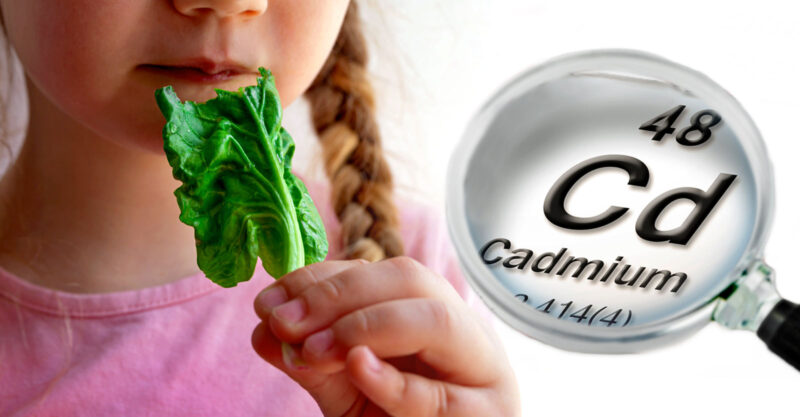Worrisome levels of potentially cancer-causing metal found in children’s diets
Young children are being exposed to a potentially cancer-causing heavy metal known as cadmium through many of the foods they eat, often at levels that exceed safety standards, according to a new study.
Cadmium has been shown to contaminate water,
air and crops, including a range of foods considered healthy that are
used in baby food. The study, which
was published in the journal Food and Chemical
Toxicity, found that the cumulative average daily levels of cadmium
ingested by children were higher than daily cadmium intake levels considered safe by
the US Agency for Toxic Substances and Disease Registry (ATSDR).
For instance, children between 6 months and 24 months who consumed spinach and rice at least once a week ingested cadmium that exceeded the ATSDR guidelines by up to 200%, the study determined.
The authors of the
study warned that the findings are particularly concerning because the bodies
of young children are still developing, and may be more susceptible to the
effects of heavy metal exposure.
The study comes after a 2021 US Congressional report showed
dangerous levels of metals in infant food, prompting the US Food and Drug
Administration (FDA) to launch a research and action plan to assess the risks
of heavy metals in foods.
Cadmium occurs naturally in soil, but the main sources of
cadmium pollution in the environment are the burning of fossil fuels, waste
incineration, mining, and fertilizer manufacture, according to the US
Environmental Protection Agency (EPA). Cadmium from industrial sources can
settle on agricultural fields via air pollution, or contaminate crops through
cadmium-laden water.
Cadmium has long been a known threat to public health.
The EPA classifies the metal as a probable carcinogen, and cadmium has also
been linked to other health problems, such as kidney dysfunction.
Toxic toddler diets
The primary sources of cadmium exposure for all Americans include leafy green vegetables, cereal grains, potatoes, nuts, and seeds. Researchers estimated the exposure risks of different age groups by evaluating the typical diets of those age groups, as well as how often they consumed six foods with high cadmium levels: rice, spinach, oats, barley, potatoes, and wheat.
Researchers found that children aged 6 months to 5 years
old had the highest exposures to those foods high in cadmium, many of which are
common ingredients in commercial infant food, according to the study.
Exposures to cadmium in children are important to track as children consume more food and fluids relative to their body weight, increasing the risk of cadmium accumulating in their body tissues.
Children may
also be more likely to suffer adverse impacts of cadmium exposure due to their
still-developing bodies, making them a “vulnerable” population, according to
the new study.
Past research has shown links between
cadmium exposure and possible neurological effects in children.
Since the researchers only evaluated the risk of cadmium
exposure for six foods, cumulative exposure from all foods consumed in the US
could be much higher, according to the paper.
Reducing cadmium exposures
Reducing cadmium exposure for children may mean that
infant food manufacturers must change the ingredients they use, according
to the 2021 Congressional
report on heavy metals in baby food.
“Step one to restoring that trust is for manufacturers to
voluntarily and immediately reduce the levels of toxic heavy metals in their
baby foods to as close to zero as possible. If that is impossible for foods
containing certain ingredients, then those ingredients should not be included
in baby foods,” the authors of that report wrote.
Parents should decrease the number of days per week a
child is exposed to cadmium from specific foods, such as rice and spinach, by
feeding children a varied diet, according to Katarzyna Kordas, a professor of
environmental health at the University at Buffalo who was not involved in the
new study. “Offer many different foods during the week,” she said.
Reducing the amount of cadmium that enters the food
supply in the first place is also key, experts say.
Scientists are studying the ways that different food
crops take up cadmium, with the hopes to identify varietals of crops that
incorporate less cadmium from the soil, said Kordas. The FDA has also recommended that manufacturers reduce the
use of cadmium in food-production equipment.
Last year, the Center for Biological Diversity (CBD), an
environmental advocacy group, filed a lawsuit against
the EPA for nearly tripling the cadmium levels allowed in fresh water, which
the group claimed would harm endangered fish and sea turtles. Fossil fuel
burning and the use and production of fertilizers contribute more than 90% of
cadmium found in fresh water, according to CBD.
“A cleaner environment overall, from air to water, would
help reduce food contamination, and regulation of industries and their
processes would help in this,” said Kordas.
